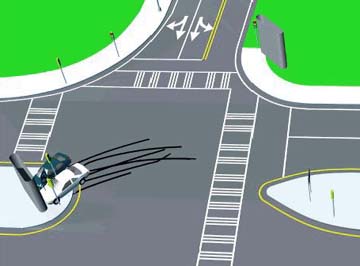

Expert says ex-officer Former police officer Clyde Arakawa was severely impaired by alcohol the night of Oct. 7, 2000, and was the primary cause of the two-car collision that killed Dana Ambrose, a research psychologist testified yesterday.
was severely impaired
A specialist calculated Arakawa's
condition at the time of the crashBy Debra Barayuga
dbarayuga@starbulletin.comMarcelline Burns, who has researched the effect of alcohol and drugs on human performance since 1969, said her calculations showed Arakawa's blood alcohol concentration, or BAC, at the time of the crash was between .15 and .17 -- nearly twice the legal limit of .08.


|
"Mr. Arakawa had a very high BAC, an impairing BAC, and I believe was a major cause of this accident," Burns said. At those levels, the degree of impairment is "so severe, it's irrelevant whether it's .15 or .17."Arakawa, on trial for manslaughter for causing Ambrose's death, has maintained he had the green light and was not drunk or speeding when he struck her car at Pali Highway and School Street just before midnight.
Burns, who was part of a group that developed the standard field sobriety test adopted by the U.S. Department of Transportation and used by law enforcement in all 50 states, calculated Arakawa's blood alcohol concentration using his weight, how long he had been drinking that night and the average rate that alcohol metabolizes in a person's system.
She got similar results when she extrapolated his blood alcohol concentration at the time of the collision using the .06 level recorded seven hours after his arrest and the rate of metabolism over that seven-hour period.
Alcohol, a depressant, slows the brain's ability to process information, impairs judgment and increases risk-taking, Burns said. Any alcohol in a person's system affects his performance at the wheel regardless of whether he is an experienced driver or experienced drinker, she said.
Burns said alcohol can cause drivers to have "tunnel attention" -- paying attention only to what is straight ahead. A majority of alcohol-related crashes result from a driver's failure to perceive or to misinterpret what they see, she said.
Burns said the effects of alcohol on Arakawa were evident on video taken by cameras at Side Street Inn, one of two establishments that served him alcohol the night of the fatal crash. The video showed Arakawa and two others drinking with him losing their inhibitions and becoming more extroverted or demonstrative, she said.
Also yesterday, Kenneth Baker, a nationally known expert on accident reconstruction, showed the jury a computer simulation he had created of the crash. He has previously testified for the state in the murder trials of Dana Ireland and Yvonne Mathison, wife of convicted police Sgt. Kenneth Mathison.
Baker estimated Arakawa's Thunderbird as traveling about 57 mph and Ambrose's Honda at 32 mph when they collided.